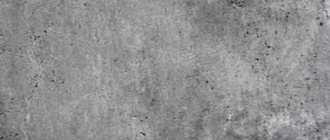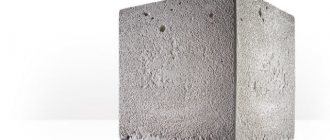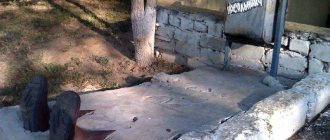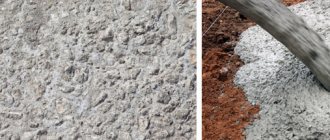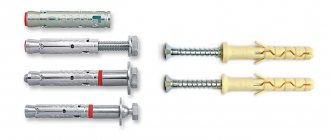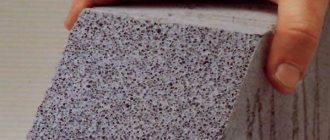Natural stone has always been a strong building material, characterized by a long service life. The cost of such material and construction work using it has always been high, because the bulk of the money was spent on mining and processing stone. For this reason, M350 concrete was created, which is an analogue of natural stone. Due to its qualities, this brand of concrete mortar is an excellent solution for the construction of complex facilities. After hardening, such a composition confidently resists external influences and has high performance, of which compressive strength stands out. Today in the construction industry, concrete 350 occupies a leading position in use and sales.
Composition and proportions of the mixture
Concrete grade M350 B25 is an elite type of heavy concrete with increased strength characteristics. It is used for the construction of buildings that regularly experience severe physical, mechanical, and atmospheric loads.
Important! Thanks to the precisely calibrated composition and the inclusion of high-quality components, the material also has high compressive and tensile strength.
Main components of M350 concrete:
- sand;
- crushed stone;
- cement.
The solution may contain screenings to partially replace the filler, antifreeze additives, modifiers and plasticizers.
For concrete M350, sand is selected from one of three fractions - medium, coarse, fine. Crushed stone or gravel can be of granite or calcareous origin (the introduction of both filler options is allowed).
Nevertheless, granite crushed stone with a density of about 2600 kg/m³ will further increase the strength of concrete, although it will negatively affect its price (it will be 7-10% higher). Granite has a density of 800 kg/m³, but it reduces the cost of production.
Crushed granite
Cement of grades M400 or M500 is introduced into the composition in an increased volume, due to which the material quickly sets. Plasticizers accelerate the hydration process and increase the resistance of concrete to moisture.
In addition to choosing the appropriate components, it is equally important to strictly observe their proportions:
- 1 part cement M400;
- 1.5 parts sand;
- 3.1 parts of crushed stone.
Important! For 1 part of M500 cement, take 1.9 parts of sand, 3.6 parts of crushed stone. To mix 1 cubic meter of concrete you will need 380 kg of M500 cement, 1370 kg of crushed stone or gravel, 720 kg of sand and 175 liters of water, as well as a plasticizer (according to the instructions).
Compound
Concrete mortar is a mixture whose recipe is as follows:
- cement material;
- water;
- sand;
- fillers in the form of granite or crushed gravel.
To improve the properties of concrete, plasticizer additives can be mixed into the composition, allowing you to expand the range of use of this brand. One example is concrete w25 p4 m350, which, in addition to the main ingredients, contains plasticizers and additives that improve frost resistance.
It should be noted that the components used in the preparation of concrete mortar differ in parameters and characteristics - particle size, purity, humidity and strength. In one case, the filler can be fine-grained, coarse or medium-grained sand. In addition, M350 concrete can be made on granite. There are known cases when M350 concrete was produced from crushed stone screenings.
Note that the increased percentage of Portland cement contained in concrete class 25 m350 shortens the strength gain schedule of concrete m350.
Specifications
After final hardening, M350 concrete has the following characteristics:
- Mobility – P2-P4. The indicator can increase to P5 due to the addition of plasticizers, but they are not always needed. The higher the value, the more fluid the material becomes, which expands its scope of application.
- Frost resistance - up to F. Concrete will not lose its characteristics over 200 cycles of freezing and defrosting. Such high frost resistance allows the M350 to be used outdoors and in the harshest climates.
- Water resistance - W. There are almost no cavities or air bubbles inside the structure made of concrete grade M350, which enhances the protection of the material from moisture penetration. If the concrete is in the shape of a 15 cm cone, it will withstand a water pressure of 8 kg/cm².
- Compressive strength – 33 MPa. Also, to determine the technical characteristics of the material, its tensile strength during bending, equal to 3-3.6 MPa, is important.
- Specific gravity – 2320 kg/m². This figure allows the material to be classified as heavy concrete.
General recommendations
- It is recommended to lay M350 in layers 15-20 cm thick, and then compact it twice with a vibration compactor - immediately after pouring and after 40-60 minutes.
- The optimal climatic regime for hardening the concrete mixture to reach its nominal characteristics within 26-30 days is 15-35 degrees Celsius and a humidity of 65-70 percent. If the current temperature/humidity does not correspond to the indicated parameters, it is necessary to take measures to protect the monolith from potential damage by moisturizing, cooling, warming, adding additives, and so on.
- M350 gains critical strength 10-12 days after pouring under optimal environmental conditions. The formwork is removed on the 13-15th day. Regular loads on foundations and monoliths are allowed after the final hardening and petrification of concrete.
Advantages of M350
The material can withstand the highest loads, because its strength characteristics are considered optimal. The finished concrete mass is resistant to destruction and the influence of abrasive, compressive and tensile loads.
Other advantages of M350 concrete:
- High mobility of the solution. Concrete turns out to be very easy to lay.
- The presence of additives that increase frost resistance. These substances allow you to work with concrete all year round, and also use it regardless of the climate. The design is structurally integral and does not lose this property throughout its entire service life.
- Long maintenance-free service life. Buildings and structures made of M350 concrete are able to resist the action of natural factors - precipitation, wind, ultraviolet radiation. They are considered resistant to aggressive environments, so they last for many years.
- Sufficient density. The structures are reliable, durable, and can withstand impacts and other mechanical loads.
- Moisture resistance. The water resistance class of concrete M350 expands the possibilities of its use and provides a significant degree of protection against moisture penetration.
- Environmentally friendly. The material does not contain harmful impurities, it is safe for people and the environment.
Laying rules
- Remove debris and dirt from the surface: slate, polyethylene, sand that has floated after rain.
- When installing formwork, pay special attention to the quality of its fastening. M350 is heavy concrete, it can burst open poorly secured structures. Use jumpers, spacers, stakes.
- Vibrate the solution or use the shovel method, which will reduce the likelihood of air pockets and reduce the number of pores.
- Make sure that the reinforcement is completely hidden in the concrete. If it rests on the ground (on the formwork), cut it off, otherwise corrosion will quickly begin to develop from this place.
- Protect freshly poured concrete from rain. Rain can wash away the cement from the top layer of the mixture.
- The next day after pouring, water the screed or foundation. If the air temperature is above 15°C, you need to water several times a day for 3-5 days.
Disadvantages of the M350
M350 concrete is considered strong, durable and belongs to the elite, but it still has its drawbacks:
- Fluidity. In some cases, this property may become not an advantage, but a disadvantage of the building material. If a plasticizer is added to the composition, the finished solution will not be suitable for all types of concreting work.
- Large amount of cement. Due to the increased rate of binder, concrete quickly thickens, hardens, and must be delivered to the construction site or poured into molds in an extremely short time.
- High price. The cost of a cubic meter of concrete mixture in this category is higher than that of lower-quality analogues. This inevitably increases overall construction costs.
Concrete M350 sets quickly
Properties of concrete mixture M350
Concrete mix M350 is a ready-to-use homogeneous solution based on binder, aggregates, water with the addition of chemical additives. The properties of concrete M350 in the liquid state are regulated by GOST 7473-2010:
- Workability is the ability to fill the space of the formwork during the pouring process without creating voids. Concrete mortar grade M350 for workability: for cone spread P3-P5, for cone settlement - P1-P4, for rigidity - Zh3-Z5, for compaction - KU1-KU5. The workability indicators of the solution are set by the consumer and are regulated using chemical additives: plasticizing, superplasticizing, and regulating mobility.
- Layering is the division of concrete mortar into separate fractions in layers consisting of individual components. The maximum permissible stratification for mixtures of grades P3-P5 and P1-P6 is: no more than 0.8% for water separation and no more than 4% for solution separation.
- Average density is the ratio of the mass of a concrete mixture to its volume. The density of M350 concrete is 2200-2400 kg/m3, depending on the type of fillers used. The maximum deviation from the density specified in the passport is +/-20%.
Concrete mortar M350 retains its original properties in a static state for at least 1 hour 30 minutes. With constant forced stirring - at least 3 hours. To increase the life of the concrete mixture, hardening retarders, frost-resistant additives, and superplasticizers are introduced into the composition.
Strength classes
Concrete grade M350 corresponds to strength class B25. The brand designation indicates a rounded indicator of compressive strength in kgf/cm² when converted from MPa.
Important! The grade reflects the cubic strength of the concrete sample.
According to the standards, in 95 cases out of 100 this sample can withstand pressure of at least 25 MPa. In addition, M350 can be designated by the abbreviation BST (heavy concrete).
Waterproof and frost-resistant
Water resistance is the ability of a concrete stone to withstand water pressure without letting it in. Concrete M350 has a waterproof grade of W6-W10. This means that the concrete structure is able to withstand the positive or negative effects of water with a pressure of 6 to 10 MPa. The water resistance of the concrete mixture is specified by the consumer.
Water resistance tests are carried out in accordance with GOST 12730.5. To increase the indicator, air-entraining additives that reduce permeability are introduced into the solution. To impart water-repellent properties to monolithic structures, water-repellent additives are used.
Frost resistance is the property of a material to withstand freezing and thawing cycles without loss of strength. The frost resistance of M350 concrete ranges from F100 to F300. This means that the monolithic structure will withstand 100-300 freeze/thaw cycles and at the same time will correspond to class B25 in strength. Frost resistance tests are carried out in accordance with GOST 10060. To increase frost resistance, antifreeze additives are introduced into the concrete mixture.
Areas of use
Concrete M350 is used in a variety of areas of construction and repair. It is considered one of the most popular compounds for commercial construction because it can withstand high loads.
The material is ideal for pouring monolithic foundations for large objects. It is rarely used to create foundations for ordinary low-rise buildings due to its high cost. The safety margin of such a house foundation will be too large and simply unclaimed.
Other areas of use of M350 concrete:
- Construction of reinforced concrete structures. Often, the material is poured directly into a hole drilled for support, with the walls pre-treated.
- Organization of floor slabs with many voids. Such products are light but durable; they do not require reinforcement, but their performance properties remain high.
- Creation of airfield and road slabs, including those used under the highest loads. To obtain such products, concrete is poured into molds and reinforced using special hydraulic equipment.
- Construction of columns and load-bearing floors. Finished products will withstand compression, pressure, and stretching without problems.
Concrete work at the airport
Important! M350 grade concrete is used to make swimming pool bowls, structures in areas where groundwater rises to great heights, tunnels, bridges, crane beams of buildings, septic tank and sewer wells, stairs and flights, and other critical structures.
Where is concrete used?
Concrete B27 with maximum strength and frost resistance (F200) is used to create hollow-core and airfield slabs, and for coatings and structures designed for extreme loads.
Using various additives, you can change the class of concrete over a wide range. At different stages of construction, different parameters are required from the material. Mortars with the greatest strength and durability are used for pouring monolithic foundations of multi-story buildings. They are used to fill columns, floors, beams and other load-bearing structures. Residential and commercial buildings are made from this concrete.
M 350 is used for pouring monolithic reinforced concrete in the construction of stairs, spans, wells, sewage treatment plants and other structures operating under various loads.
Increased moisture resistance allows the use of concrete of this grade in conditions where the structure is exposed to groundwater and melt water, as well as large quantities of precipitation. They are excellent for the construction of runways at airfields and underground facilities.
Component quality
In order for the solution to meet the requirements of GOST, it is necessary to strictly monitor the quality of its components. Only fresh cement is used, which was produced no later than 6 months before the production of M350 concrete.
Cement must be properly stored under optimal conditions of humidity and temperature. To check the quality, take it in your hand, squeeze it well into a fist and evaluate the condition - the powder should be crumbly, loose, and not stick together.
If the composition contains lumps, its properties are no longer optimal: most likely, storage rules were not followed. The specific gravity of the final mixture greatly depends on the brand of cement, so low-grade binders are not suitable for production.
The sand must also be of high quality: dry, purified, without impurities (especially clay). If necessary, the sand is washed and sifted.
If any component of the solution has high humidity, the amount of water is reduced. As for the latter, clean drinking water without chemical additives is suitable for M350 concrete - this is exactly what is used in industrial conditions.
Important! Low quality water seriously degrades the properties of concrete.
Advantages and disadvantages
The advantages of the M350 include:
- Versatility. Concrete mixtures are used in private and industrial construction.
- Possibility of optimization of technical and operational characteristics. If necessary, the material parameters are changed using additives.
- Functional post-processing. Any types of building structures based on the mixture can be sanded, coated with impregnations, and other procedures carried out without any harm to the concrete.
The disadvantages include:
- High level of mobility and fast hardening. Due to the specific technical and operational characteristics, the concrete mixture is highly mobile and hardens quickly, which predetermines the need for its prompt use after preparation, as well as professional adherence to pouring technology.
- Price. The products are quite expensive, which significantly narrows their scope of application in private construction.
Independent preparation of the solution and its installation
When creating a solution, it is important to strictly maintain the proportions of the components and follow the sequence of their connection. We are only talking about making up the ingredients yourself: when you buy a ready-made mixture, you just need to dilute it with water.
For work, it is mandatory to purchase a concrete mixer, since manual mixing does not make it possible to obtain a perfectly smooth, homogeneous mass. In addition, mixing crushed stone will cause unreasonably high labor costs.
Concrete mixer Kraton BEETONE 120
The course of action for the production of concrete grade M350 is as follows:
- Load sand and cement into a concrete mixer container and mix the components well.
- Pour in water without stopping stirring the mass (if modifiers and plasticizers are present in the composition, they are dissolved in the liquid in advance).
- Gravel or crushed stone is sprinkled with a little water, introduced into the general solution, and stirring is started again until a homogeneous mass is obtained.
Concrete of this brand, like other heavy concretes, sets very quickly. Filling is carried out within a maximum of two hours after preparation, otherwise the mixture will be spoiled.
If this is not possible, or if a concrete mixer is not available, it is recommended to order ready-mixed concrete M350 at the nearest plant. The quality of the composition will be higher, and the construction process will be reduced in time.
Before pouring the solution, carefully prepare the base - clean it of dust, debris, and dirt. Afterwards, formwork is installed from lumber (boards, bars, pieces of chipboard), or a ready-made structure is purchased or ordered.
In order for the formwork to be able to withstand the weight of the concrete monolith, it is reinforced in advance with lintels and spacers. If possible, make the formwork permanent - the polyurethane foam in its composition will serve as additional insulation.
Important! The screed or foundation must be reinforced with metal mesh or reinforcement.
After layer-by-layer pouring of M350 concrete, it is distributed as evenly as possible inside the mold and vibration is applied. Using a deep vibrator, you can get rid of cavities and voids in cement stone, improve its quality and ensure all the proper properties and technical characteristics.
It is equally important to provide optimal conditions for setting and complete drying of the composition. During the first 10 days, the surface of the monolith is irrigated with water and protected from precipitation and sunlight.
The structure reaches its final strength 28 days from the moment of pouring. At elevated air temperatures, this period may be slightly reduced and vice versa.
Designation and explanation
The brand is designated by the letter “M” and numbers, where the numbers indicate the design compressive strength of concrete, expressed in kilograms per square centimeter. M350 means that hardened concrete can withstand a nominal load of 350 kg/cm². Please note that:
- The strength of a completely hardened solution is indicated. Under normal conditions at a temperature of +15°C, concrete dries within 28 days. When the temperature drops and/or the humidity is high, the setting time increases.
- A load of 350 kg/cm² is calculated for prototypes: concrete cubes measuring 15x15x15 cm. If the finished product is larger than the specified dimensions, the load resistance increases.
- The grade indicates average strength with a coefficient of variation of 13.5%. This means that the actual strength is in the range of 302-397 kg/cm².
Cost of concrete M350
The price of a cubic meter of M350 concrete depends on the region, manufacturer and additives included in the material. If in a given area raw materials are imported from afar, the cost of the finished product increases. On the contrary, for manufacturers who independently prepare or extract all the components, the price of concrete will be lower.
Important! The average cost of a cubic meter of M350 brand solution is 3600-4600 rubles.
Despite the high price, M350 concrete remains a popular material for the construction of critical structures that undergo high loads. It maintains its integrity for a long time, is not afraid of the influence of negative factors and can be considered one of the most durable and reliable compounds.
Price
The price of finished products from manufacturers ranges from 3-3.5 thousand rubles per cubic meter of material. The cost is affected by the quality of the components, the need to use additives, and the distance to the final delivery point. For short distances, the concrete mixture is delivered by dump truck. Otherwise, special transport in the form of an automixer is used.
Self-production of M350 manually reduces the cost of production by 10-20 percent, but is not suitable for industrial construction, since it often requires large volumes of concrete for pouring, prompt implementation of the procedure to prevent deterioration in the technical and operational properties of the material during its short-term storage.

